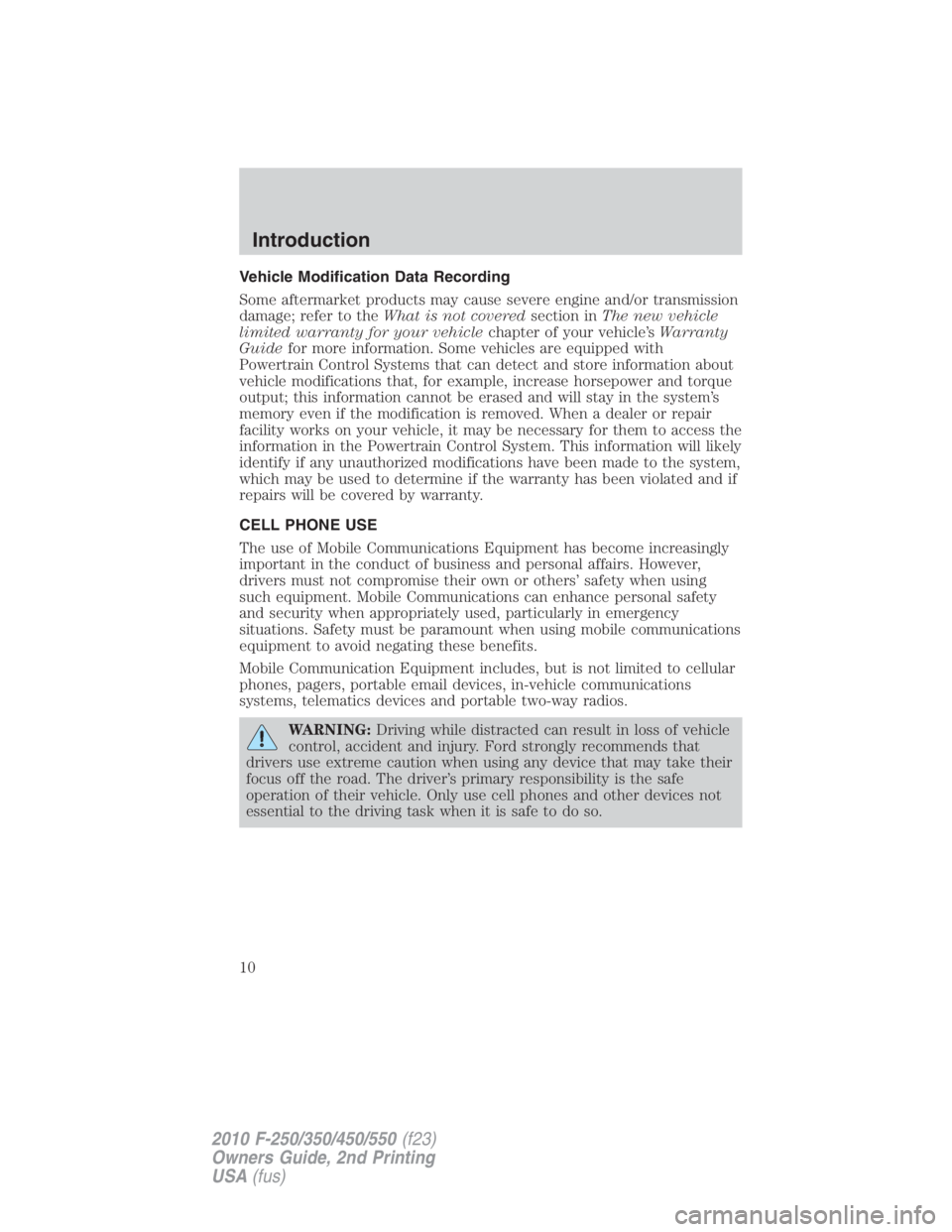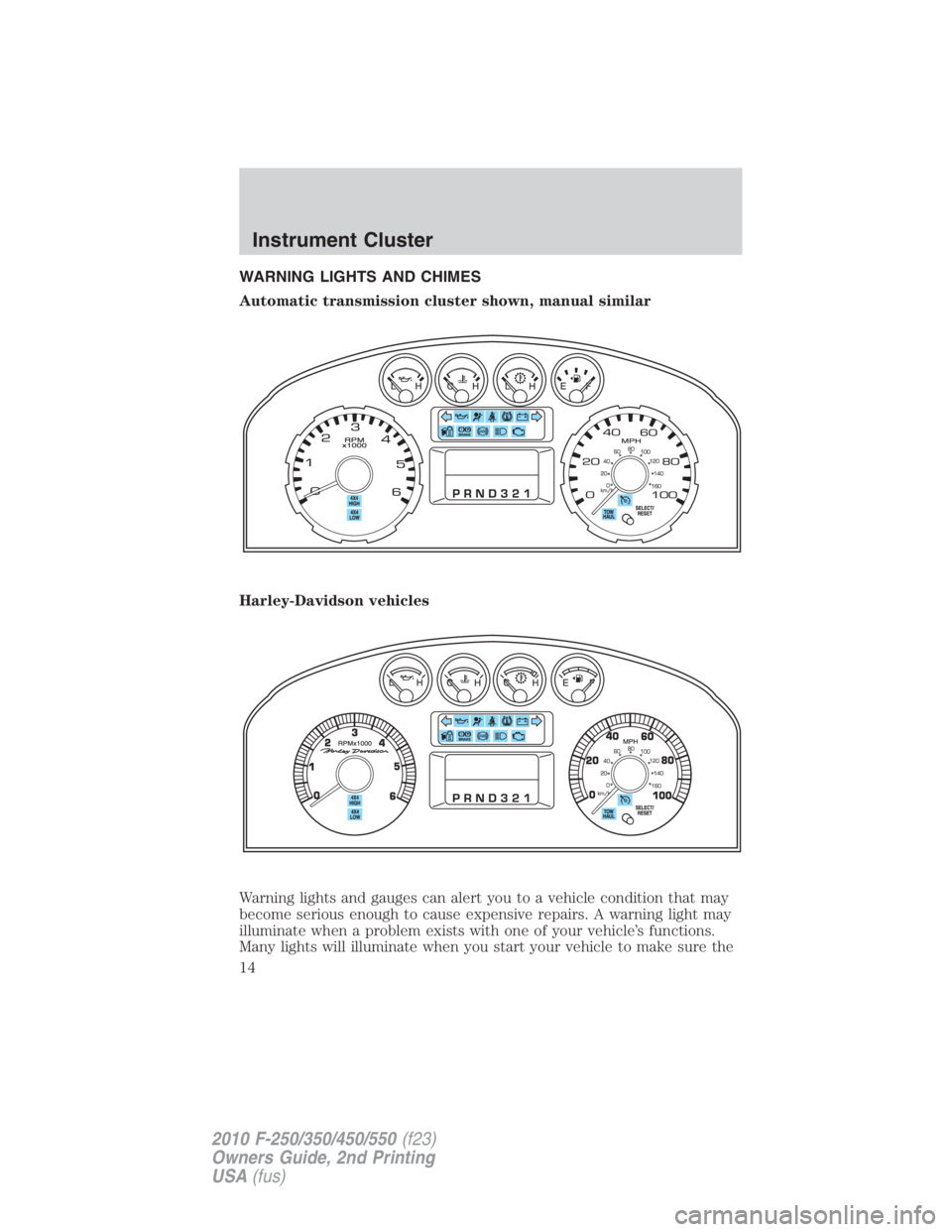2010 FORD F450 transmission
[x] Cancel search: transmissionPage 2 of 408

Locks and Security 148Keys 148
Locks 148
Anti-theft system 159
Seating and Safety Restraints 164Seating 164
Safety restraints 173
Airbags 185
Child restraints 195
Tires, Wheels and Loading 217Tire information 219
Tire inflation 221
Tire Pressure Monitoring System (TPMS) 237
Vehicle loading 244
Trailer towing 251
Trailer brake controller-integrated 256
Recreational towing 262
Driving 264Starting 264
Brakes 269
Traction Control™ 271
Transmission operation 275
Reverse sensing system 280
Rear-view camera system 282
Roadside Emergencies 303Getting roadside assistance 303
Hazard flasher control 304
Fuel pump shut-off switch 305
Fuses and relays 306
Changing tires 315
Wheel lug nut torque 330
Jump starting 331
Wrecker towing 336Table of Contents
2
2010 F-250/350/450/550 (f23)
Owners Guide, 2nd Printing
USA (fus)
Page 10 of 408

Vehicle Modification Data Recording
Some aftermarket products may cause severe engine and/or transmission
damage; refer to the What is not covered section in The new vehicle
limited warranty for your vehicle chapter of your vehicle’s Warranty
Guide for more information. Some vehicles are equipped with
Powertrain Control Systems that can detect and store information about
vehicle modifications that, for example, increase horsepower and torque
output; this information cannot be erased and will stay in the system’s
memory even if the modification is removed. When a dealer or repair
facility works on your vehicle, it may be necessary for them to access the
information in the Powertrain Control System. This information will likely
identify if any unauthorized modifications have been made to the system,
which may be used to determine if the warranty has been violated and if
repairs will be covered by warranty.
CELL PHONE USE
The use of Mobile Communications Equipment has become increasingly
important in the conduct of business and personal affairs. However,
drivers must not compromise their own or others’ safety when using
such equipment. Mobile Communications can enhance personal safety
and security when appropriately used, particularly in emergency
situations. Safety must be paramount when using mobile communications
equipment to avoid negating these benefits.
Mobile Communication Equipment includes, but is not limited to cellular
phones, pagers, portable email devices, in-vehicle communications
systems, telematics devices and portable two-way radios.
WARNING: Driving while distracted can result in loss of vehicle
control, accident and injury. Ford strongly recommends that
drivers use extreme caution when using any device that may take their
focus off the road. The driver’s primary responsibility is the safe
operation of their vehicle. Only use cell phones and other devices not
essential to the driving task when it is safe to do so.Introduction
10
2010 F-250/350/450/550 (f23)
Owners Guide, 2nd Printing
USA (fus)
Page 14 of 408

WARNING LIGHTS AND CHIMES
Automatic transmission cluster shown, manual similar
Harley-Davidson vehicles
Warning lights and gauges can alert you to a vehicle condition that may
become serious enough to cause expensive repairs. A warning light may
illuminate when a problem exists with one of your vehicle’s functions.
Many lights will illuminate when you start your vehicle to make sure theInstrument Cluster
14
2010 F-250/350/450/550 (f23)
Owners Guide, 2nd Printing
USA (fus)
Page 17 of 408

Low tire pressure warning (if
equipped): Illuminates when your
tire pressure is low. If the light
remains on at start up or while
driving, the tire pressure should be
checked. Refer to Inflating your tires in the Tires, Wheels and
Loading chapter. When the ignition is first turned to on, the light will
illuminate for three seconds to ensure the bulb is working. If the light
does not turn on, have the system inspected by your authorized dealer.
For more information on this system, refer to Understanding your tire
pressure monitoring system (TPMS) in the Tires, Wheels and
Loading chapter.
Charging system: Illuminates when
the battery is not charging properly.
If it stays on while the engine is
running, there may be a malfunction
with the charging system. Contact your authorized dealer as soon as
possible. This indicates a problem with the electrical system or a related
component.
Powertrain malfunction/Reduced
power/Electronic throttle
control (RTT): Displays when the
engine has defaulted to a
“limp-home” operation or when a transmission problem has been
detected and shifting may be restricted. If the light remains on, have the
system serviced immediately by your authorized dealer.
Traction control (RTT) (if
equipped): Displays when the
traction control system is active. If
the light remains on, have the
system serviced immediately by
your authorized dealer. Refer to Traction control in the Driving chapter
for more information
Check fuel cap (RTT): Displays
when the fuel cap may not be
properly installed. Continued driving
with this light on may cause the
Service engine soon warning light to
come on. Refer to Fuel filler cap in
the Maintenance and Specifications chapter.Instrument Cluster
17
2010 F-250/350/450/550 (f23)
Owners Guide, 2nd Printing
USA (fus)
Page 18 of 408

Engine coolant temperature
(RTT): Displays when the engine
coolant temperature is high. Stop
the vehicle as soon as safely possible, switch off the engine and let it
cool. Refer to Engine coolant in the Maintenance and Specifications
chapter.
WARNING: Never remove the coolant reservoir cap while the
engine is running or hot.
Low fuel (RTT): Displays when
the fuel level in the fuel tank is at
or near empty (refer to Fuel gauge
in this chapter).
Door ajar (RTT): Displays when
the ignition is in the on position and
any door is open.
Transmission Tow/Haul Feature
(automatic transmission) (if
equipped): The Tow Haul light
remains illuminated as long as the
Tow/Haul feature is activated. Refer to the Driving chapter for
transmission function and operation. If the light remains illuminated and
will not cancel using the Tow/Haul switch located on the end of the gear
shift lever, have the system serviced immediately or damage to the
transmission could occur.
Four-wheel drive low (if
equipped): Illuminates when
four-wheel drive low is engaged.
Four-wheel drive high (if
equipped): Illuminates when
four-wheel drive high is engaged. 4x4
LOW
4x4
HIGHInstrument Cluster
18
2010 F-250/350/450/550 (f23)
Owners Guide, 2nd Printing
USA (fus)
Page 23 of 408

Engine oil pressure gauge:
Indicates engine oil pressure. The
needle should stay in the normal
operating range (between “L” and
“H”). If the needle falls below the
normal range, stop the vehicle, turn
off the engine and check the engine
oil level. Add oil if needed. If the oil
level is correct, have your vehicle checked at your authorized dealer.
Fuel gauge: Indicates
approximately how much fuel is left
in the fuel tank (when the ignition
is in the on position). The fuel
gauge may vary slightly when the
vehicle is in motion or on a grade.
The FUEL icon and arrow indicates
which side of the vehicle the fuel
filler door is located.
Refer to Filling the tank in the Maintenance and Specifications
chapter for more information.
Battery voltage gauge (manual
transmission only): Indicates the
battery voltage when the ignition is
in the on position. If the pointer
moves and stays outside the normal
operating range, have the vehicle’s
electrical system checked as soon as
possible.
Transmission fluid temperature gauge (automatic transmission
only): If the gauge is in the:
Normal area– the transmission
fluid is within the normal operating
temperature (between “H” and “C”). Instrument Cluster
23
2010 F-250/350/450/550 (f23)
Owners Guide, 2nd Printing
USA (fus)
Page 24 of 408

Yellow area– the transmission fluid
is higher than normal operating
temperature. This can be caused by
special operating conditions (i.e.
snowplowing, towing or off road
use). Refer to Special operating
conditions in the scheduled
maintenance information for
instructions. Operating the transmission for extended periods of time
with the gauge in the yellow area may cause internal transmission
damage.
Altering the severity of the operating conditions is recommended to
lower the transmission temperature into the normal range.
Red area– the transmission fluid is
overheating. Stop the vehicle to
allow the temperature to return to
normal range.
If the gauge is operating in the Yellow or Red area, stop the vehicle and
verify the airflow is not restricted such as snow or debris blocking airflow
through the grill. If the gauge continues to show high temperatures, see
your authorized dealer.
STANDARD MESSAGE CENTER
Your vehicle’s message center is capable of monitoring many vehicle
systems and will alert you to potential vehicle problems and various
conditions with an informational message followed by a long indicator
chime.
The message center display is located in the instrument cluster.
Selectable features (information menu)
Press and release the SELECT/RESET button, located in the
speedometer, to scroll and reset the following functions. Select or reset
the function by holding the SELECT/RESET button for more than
2 seconds.
TRIP
Registers the distance of individual journeys. Press and release the
SELECT/RESET button on the cluster to toggle between odometer and
trip odometer display. To reset, press and hold for less than two seconds.Instrument Cluster
24
2010 F-250/350/450/550 (f23)
Owners Guide, 2nd Printing
USA (fus)
Page 28 of 408

In the event of a multiple warning situation, the message center will
cycle the display to show all warnings by displaying each one for four
seconds.
The message center will display the last selected feature if there are no
more warning messages.
Types of messages and warnings:
• Some messages will appear briefly to inform you of something you
may need to take action on or be informed of.
• Some messages will appear once and then again when the vehicle is
restarted.
• Some messages will reappear after clearing or being reset if a problem
or condition is still present and needs your attention.
• Some messages can be acknowledged and reset by pressing the
SELECT/RESET button. This allows you to use the full message
center functionality by clearing the message.
PARK BRAKE ENGAGED — Displayed when the parking brake is
applied (or not fully released).
CHECK BRAKE SYSTEM — Displayed when a fault has been detected
by the ABS module.
DRIVER DOOR AJAR — Displayed when the driver’s door is not
completely closed.
PASSENGER DOOR AJAR — Displayed when the passenger’s door is
not completely closed.
REAR LEFT DOOR AJAR — Displayed when the rear left door is not
completely closed.
REAR RIGHT DOOR AJAR — Displayed when the rear right door is
not completely closed.
XXX MILES TO E FUEL LEVEL LOW — Displayed as an early
reminder of a low fuel condition.
CHECK PARK AID (if equipped) — Displayed when the transmission
is in R (Reverse) and the reverse sensing system (park aid) is disabled.
TO STOP ALARM START VEHICLE (if equipped) — Displayed
when the perimeter alarm system is armed and the vehicle is entered
using the key on the driver’s side door. In order to prevent the perimeter
alarm system from triggering, the ignition must be turned to start or on
before the 12–second chime expires. See Perimeter alarm system in the
Locks and Security chapter.Instrument Cluster
28
2010 F-250/350/450/550 (f23)
Owners Guide, 2nd Printing
USA (fus)